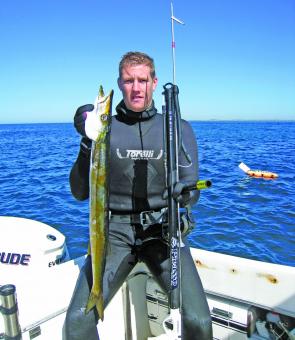When l started spearfishing 35 years ago choosing the correct speargun was quite easy. I only had a choice of a few spearguns at the local dive shop. Nowadays, there are dozens of quality manufacturers and quality retail spearfishing outlets may have over one hundred or more spearguns on display varying in price from $200 to $2000. So where do you start?
In this day and age most keen spearfishers have more than one speargun and many spearos (including yours truly) may have up to 6-8 spearguns. However, if you mainly spearfish in one geographic area it is possible to own just one speargun and make it work well for you.
The first bit of advice l would offer is ask yourself, where am l going to spearfish? Each geographic region has influencing factors such as typical species and conditions to be encountered. Most retailers and manufacturers refer to Euro-style speargun lengths in terms of stock or barrel length, i.e. distance from the front of handle to start of the front muzzle.
These guns are all rear mounted handles, single or double rubber, with 6-8mm spear shafts with either a single point or a thread to cater for screw on heads. Guns usually start at 80cm through to 130-150cm stock lengths. These guns can vary in price from $200 through to $800 depending on barrel composition, quality of shafts, length, and other factors. In short, the longer the gun the greater distance you can shoot from (if powered correctly) and the larger fish you can possibly land. Do not make a common mistake and buy too big of a gun first up. If you are in dirty or surgy water you will be cursing having a big gun.
In southern and south eastern Australia (up to around Eden, NSW) a gun length of 90-100 cm will be suitable for most conditions and species. Fish like snook, whiting, sweep and morwong will be easily landed with this type of gun. An experienced spearo will also be able to land a chance encounter with a yellowtail kingfish. From Eden through to the Sydney area a 110 or 120cm gun would suffice and be capable of landing both pelagic and reef species and fish in cleaner water. From Sydney north to Tweed Heads a 120 or 130cm should do the job for fish like mulloway, Spanish mackerel and flighty snapper. In Queensland, inshore spearfishing requires a 110-120 cm speargun and offshore at the GBR and Coral Sea a 130 or 140 cm gun should be used in these clearer waters. A 130-140 cm gun can land prized pelagic like wahoo and tuna but are also necessary sometimes to land coral trout and other quality reef fish in crystal clear waters.
The choice of spearguns for dedicated blue water spearfishing is a whole new ball game. Here we have specialised manufacturers like the US company Riffe. They manufacture a whole range of spearfishing equipment but their blue water range is really quite unique with guns with mid handles, 9.5mm shafts, slip tips and four rubbers. These guns can shoot fish at up to 8-9m away and have landed fish well over 300kg!
As far as thickness and amount of rubbers goes that is personal choice and again is influenced by the targeted fish and conditions. Generally, 16mm rubbers are easier to load and offer moderate power to a gun where as thicker 19-20mm rubbers are more challenging to load but do pack some punch. I like using a 16mm rubber in southern Australia but prefer one single 20mm rubber the further north l head. A good option for some rigs, especially the larger 130cm or 140cm guns is to use two 16mm rubbers for easier loading and greater power.
Spear shafts come in various thickness, length and composition. Again, a lot is personal choice but we tend to use thinner shafts in southern Australia where we target smaller fish and may use thicker shafts up north and around the Great Barrier Reef. Shafts are not cheap and it does hurt to see a coral trout wrapping your $80-$100 shaft around a reef. Spring stainless steel shafts have proven popular over the years and seem to last longer than the milder steel shafts.
Hand spears and Hawaiian slings are also a good option to start with. Pneumatic or air powered spearguns are not very common in Australia but are used in many other parts of the world and can be quite effective.
The trend these days is to use the single point spear heads on spearguns as opposed to cluster or multi pronged heads. The cluster head does still have its place and is used by some competition divers and spearfishers along the coast.
Reels are a great optional extra when purchasing spearguns and again are quite useful in certain situations. I would not recommend these for newcomers to the sport.
Stocks or gun barrels come in various different compositions from carbon, teak wood through to the more common aluminium. They may also have rails and these factors all influence the cost and ultimately the performance of the gun. Carbon fibre guns with rails are not cheap but do tend to be lighter in the water and more accurate. Having said that, l have no problems using a quality manufactured aluminium (generally cheapest option) gun from the shelf and taking it spearfishing.
These days we are lucky enough to have a wide range of spearguns available on the market. Retail outlets do have great spearos working as salespeople and they can offer expert advice.
Reads: 28471
Drew Fenney from Victoria with a great entry level gun for Victoria spearfishing, a 75cm Picasso Assegai.

Rob Torelli with his World Record big eye tuna and a Riffe Blue Water speargun.

A well stocked speargun rack at Legendary Skindiving Equipment, Brunswick, Victoria.




